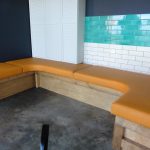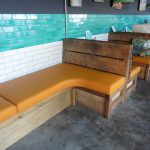Is Your Outdoor Seating Upholstery Costing You Customers?
In the dining industry, customer experience is everything. From the moment a guest walks through the doors – or onto the patio – they begin forming impressions about your brand. One overlooked yet critical component of this experience is your outdoor seating upholstery. If your cushions are faded, cracked, sagging, or simply outdated, they could be doing more harm than you think.
Let’s talk about why your outdoor seating upholstery could be driving customers away – and how upgrading it can enhance not just comfort, but your restaurant’s image, customer retention, and even revenue.
The First Impression Problem
Outdoor seating areas often serve as the first visual and physical point of contact for customers, especially in warmer months. Whether it’s a bustling sidewalk café, a rooftop lounge, or a cosy garden bistro, this space sets the tone for the dining experience.
Ask yourself:
- Are your cushions vibrant and inviting?
- Do they match your restaurant’s aesthetic?
- Are they clean and well-maintained?
Customers notice when seating looks neglected. Worn-out fabric, faded colours, or torn upholstery doesn’t just reflect poorly on your décor – it sends a signal that your business might not prioritise quality or cleanliness. Even subconsciously, this could lead guests to opt for a competitor who provides a more polished experience.
Comfort = Customer Satisfaction
It’s not just about appearances. Outdoor seating has to be comfortable – and when the padding is thin, uneven, or overly firm from weather damage, it can ruin the dining experience. No one wants to enjoy their latte or lobster roll while squirming on a lumpy, sun-scorched cushion.
In fact, comfort plays a direct role in dwell time and customer spending. Studies have shown that when guests feel comfortable, they stay longer – and order more. A beautiful, cosy outdoor setting encourages people to linger, order dessert, or go for that second round of drinks.
Upgrading your upholstery to materials designed for comfort, support, and weather resistance not only improves the guest experience but also translates to higher check averages.
Durability Matters More Than You Think
One common mistake restaurant owners make is choosing outdoor furniture or upholstery based purely on looks or price. But with unpredictable weather, UV rays, spills, and heavy traffic, outdoor seating needs to be as tough as it is attractive.
Low-quality fabric will deteriorate fast, resulting in frequent replacements and higher long-term costs. Meanwhile, high-performance commercial-grade upholstery, such as Sunbrella®, Outdura®, or marine vinyl, is engineered to withstand the elements, resist mould and mildew, and maintain its colour and shape for years.
In the long run, investing in premium outdoor fabrics pays off – not only in appearance and guest satisfaction but also in reduced maintenance and replacement costs.
Branding Through Design
Your outdoor furniture is an extension of your brand—and that includes your upholstery. Do your current cushions reflect the personality of your business?
- A modern cocktail bar might lean toward bold, monochrome upholstery with sleek lines.
- A rustic farm-to-table eatery may opt for earthy tones and textured weaves.
- A tropical-themed café could benefit from fun patterns, bright colours, or coastal motifs.
Custom upholstery lets you reinforce your brand identity visually. Whether you’re rebranding or just looking to freshen up your aesthetic, new fabric choices give you the chance to differentiate your space and make it more memorable.
The Hygiene Factor
Let’s face it – guests are more hygiene-conscious than ever. Dirty or stained cushions are a red flag. Even if they’re technically “clean,” older fabric may appear dingy or harbour odours that customers pick up on.
Modern upholstery options are designed to be easy to clean, often with antimicrobial and stain-resistant properties. A quick wipe-down should be all it takes to maintain a pristine appearance. When your patio seating looks clean, feels fresh, and smells neutral, customers feel safe and cared for.
What to Look for in an Upholstery Upgrade
Thinking it’s time for an upgrade? Here are a few tips on what to consider:
- Weather Resistance – Look for UV-resistant, water-resistant, and mildew-resistant materials.
- Comfort – Ensure sufficient padding and ergonomic support.
- Style Compatibility – Match your fabric choices with your restaurant’s branding and architecture.
- Maintenance – Choose fabrics that are easy to clean and sanitise.
- Sustainability – If eco-friendliness matters to your brand, opt for recyclable or responsibly sourced materials.
A Small Change with a Big Impact
Upgrading your outdoor upholstery doesn’t have to mean a full renovation. Even replacing seat cushions or reupholstering a few key lounge pieces can instantly refresh your space, making it feel more modern, more welcoming, and more in tune with the expectations of today’s diners.
Customers may not compliment your cushions out loud—but they will notice the difference. And they’ll remember how your space made them feel, influencing their decision to come back (or recommend you to others).
Final Thoughts: Is It Time to Upgrade?
If you’re still on the fence, do a quick audit of your outdoor seating today. Sit in the chairs. Look at them from your customers’ point of view. Run your hand along the cushions. Are you proud of what you see?
If not, an outdoor seating upholstery upgrade might be one of the simplest and smartest investments you can make. You’ll not only improve aesthetics and comfort but also elevate your brand and boost long-term profits. Because when customers feel good—they come back.
For more information on Outdoor Seating Upholstery contact Hill Upholstery.



 I (Helen) had an excuse this week to admire the restaurants seating work we did for Italian restaurant
I (Helen) had an excuse this week to admire the restaurants seating work we did for Italian restaurant 
